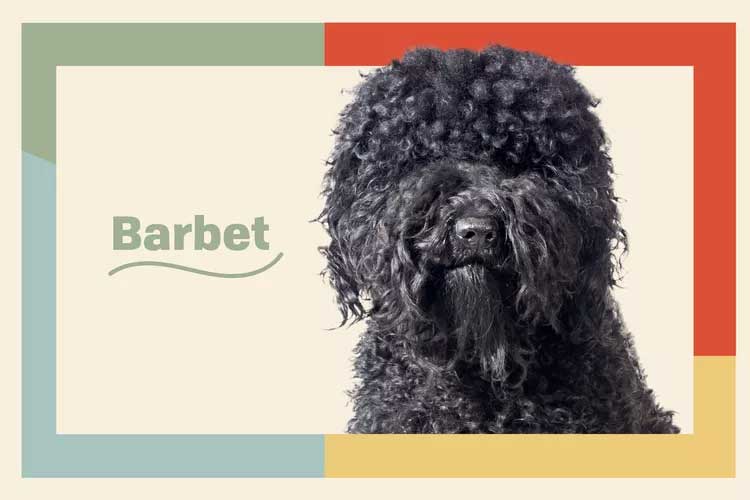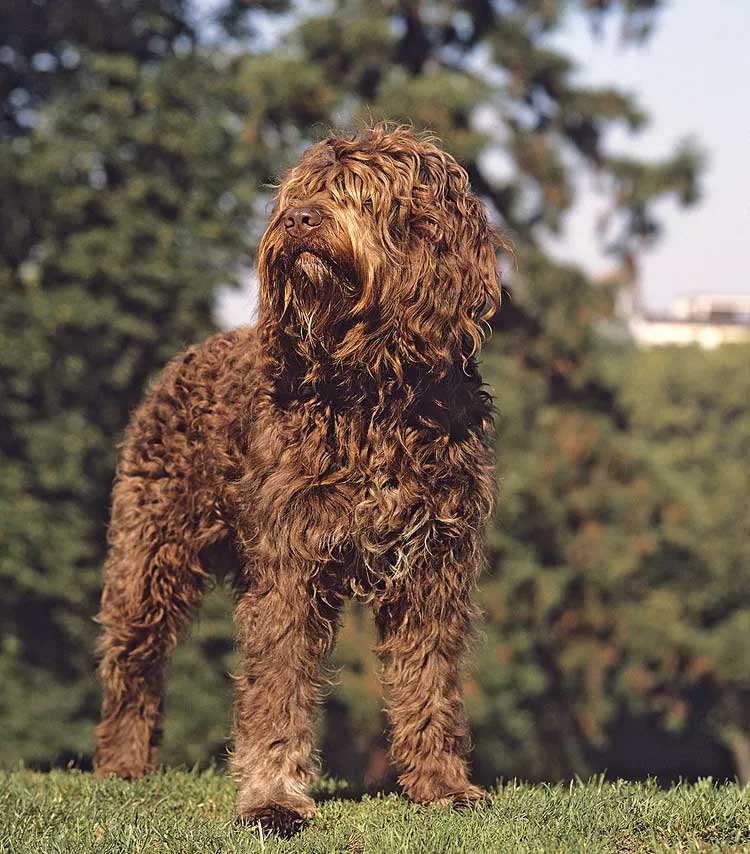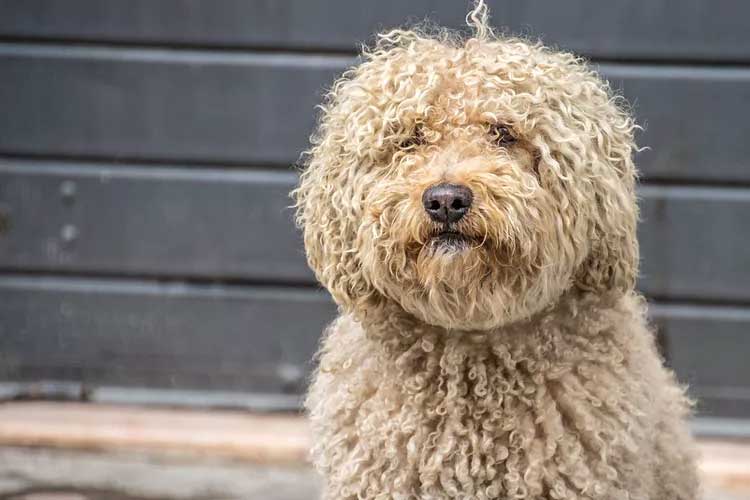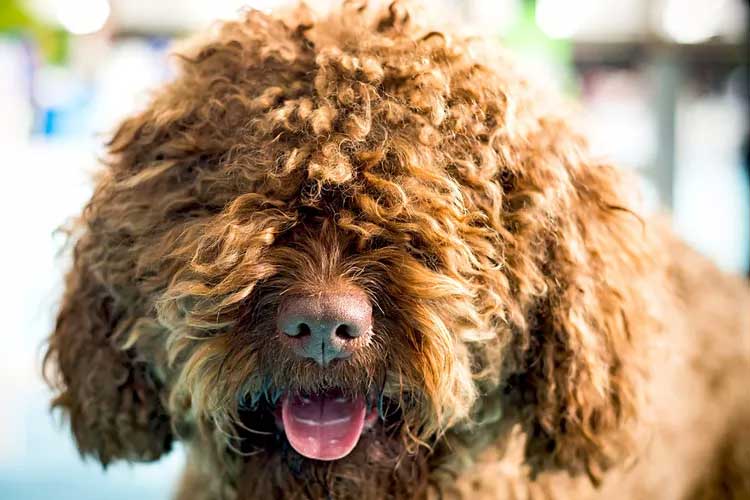Barbets are smart, fun-loving, and affectionate dogs who make the perfect addition to any family. Whether you live in an apartment or on a farm, a curly-haired barbet will be your BFF.

Barbet Overview
| OFFICIAL NAME | Barbet |
| COMMON NAME | Barbet |
| PET HEIGHT | 19 to 24 inches |
| PET WEIGHT | 35 to 65 pounds |
| LIFESPAN | 12 to 14 years |
| GOOD WITH | cats, children, dogs, families |
| TEMPERAMENT | friendly, outgoing, playful |
| INTELLIGENCE | high |
| SHEDDING AMOUNT | infrequent |
| EXERCISE NEEDS | medium |
| ENERGY LEVEL | active |
| VOCAL LEVEL | when necessary |
| DROOL AMOUNT | low |
| BREED GROUP | sporting |
| BREED SIZE | medium (26-60 lbs.) |
| COAT LENGTH | curly, long, medium |
| COLORS | black, brown / chocolate / liver, fawn, gray, white |
| PATTERNS | bicolor |
| OTHER TRAITS | apartment-friendly, cold weather tolerant, easy to train, good for first-time pet owners, good hiking companion, high prey drive, hypoallergenic, loves water, requires lots of grooming, strong loyalty tendencies |
Relative newcomers on the United States' dog scene, barbets are fun, lovable water dogs who hail from France. These mid-sized dogs are easily recognizable by their luscious curly locks and the beards that hang down from their chins.
Though they were originally bred to help hunters in their quest for waterfowl, today, barbets make ideal family pets. Though they're still relatively rare in North America, barbets are likely to grow in popularity once word gets out about their joyful personalities and family-friendly charm.
Appearance
With their big, goofy smiles and their ultra-soft curls, barbets—pronounced "bar-bay"—are adorable dogs that make the perfect addition to just about any family.Though individual dogs may vary, this breed typically stands between 19–24.5 inches tall and weighs between 35–65 pounds, according to the Barbet Club of America. Their curly hair tends to be long or medium in length and comes in black, brown, fawn, gray, and white. Barbets sometimes also have markings in black, fawn, white, brown, and gray. These pups shed and drool very little and, while no breed is truly hypoallergenic, they may be a good choice for people who suffer from allergies. They have long, sweeping tails that wag easily and often.

One of the barbet's most distinctive features is his beard, which actually helped give this breed its name! Bearded barbets hail from France, where locals call a beard a barbe.
Beards aside, barbets have large heads with bright, expressive eyes that are usually dark brown or hazel in color. Their ears hang down the sides of their faces and are also covered in wavy hair. Some people say barbets look like they would fit right in with The Muppets!
Temperament
Barbets are loyal, happy-go-lucky dogs who love to play and give lots of affection to their human owners. These dogs are sure to put a smile on your face, thanks to their goofy and cheerful dispositions.They're also highly intelligent and can learn new tricks and behaviors relatively quickly. Barbets are happy to flop down on the couch for a relaxing afternoon —so long as they've had a chance to burn off some of their energy first.
Because of their warm, affectionate personalities—and their sensitivity to the moods of people around them—barbets make great therapy dogs. Though they're fine to spend some time alone, barbets are the most content when they're around people and other pets.
"Barbets fit best with active people, says Sarah Wooten, DVM, veterinary expert for Pumpkin Pet Insurance. "They also can thrive in a family with children if they are given enough exercise and properly trained. They are social animals and do not like to be left alone for long periods of time."
Living Needs
Barbets are easy-going, adaptable dogs who can thrive in nearly any environment. They can live in apartments and other small living spaces, so long as their pet parents have time for daily walks, dog park sessions, or playtime (barbets, like nearly all dog breeds, are happiest when they get regular exercise and mental stimulation!).These pups also do well on large, securely fenced properties. In addition to regular exercise and outdoor sniffing sessions, interactive toys and food puzzles can help keep a barbet from getting bored, too.
"Barbets require ample opportunity to exercise their body and mind," says Darris Cooper, national dog training manager at Petco. "Regardless of living space accommodations, owners should be prepared to offer their barbet much of their time and affection as well as a variety of healthy outlets for physical and mental stimulation to keep their barbet feeling enriched and satiated."
Though they're generally hearty dogs, barbets aren't the best long-distance running companions, especially during the hot summer months. Because of their thick, curly coats, they can easily become overheated. On the flip side, these dogs love rolling around in snow and aren't deterred by winter's colder temperatures (no need to stock up on sweaters and coats with this breed!).

Originally bred to hunt waterfowl, barbets love to swim and play in water—and they even have webbed paws for more efficient doggy paddling. Barbets also love participating in dock diving, conformation, agility, and disc dog events, according to the Barbet Club of America (BCA).
Barbets get along well with other dogs, particularly when they've been socialized during puppyhood. If your family has a cat, it's a good idea to introduce your barbet puppy to his feline brother or sister at a young age—after that, it'll be smooth sailing. Because barbets were used as hunting dogs and have a tendency to chase small, fast-moving animals, they're not ideal for families with other small household pets such as rabbits.
This breed adores children and will quickly become any child's best friend and partner in crime. That being said, it's always a good idea for parents to supervise interactions between children and dogs, and teach children from a young age how to be respectful of pets.
Care
Because of their signature curly coats, barbets tend to fall on the higher-maintenance end of the grooming spectrum. Many barbet owners take their dogs to an experienced groomer for regular baths and haircuts, but with enough time and experience, it's also possible to groom a barbet at home."Barbets require consistent grooming in order to maintain their charming 'Muppet-like' hair-do," Cooper says.
Grooming your barbet starts with a sudsy bath with dog shampoo, followed by a good blow-dry session. Once the barbet's coat is dry and fluffy, it's time for an all-over haircut to keep the hairs between 3–5 inches long (some barbet owners keep the hair around their dog's ears and tail a bit longer for aesthetics!).

Once they've finished trimming their barbet's hair, owners need to get the dog wet again, then let his hair air-dry to curly perfection. Many barbet parents also regularly trim the hair around his eyes so he can see where he's going more clearly.
Barbets' nails tend to grow quickly, so it's important to give them regular nail trims, either with a clipper, a grinder, or some combination of the two. Because these dogs are active and like to romp around outside, it's also a good idea to clean their ears regularly to prevent any dirt and debris from building up. As with all breeds, barbets need to have their teeth brushed often at home and deep-cleaned periodically at the vet's office.
Training can be a fun bonding experience between barbets and their human owners. This breed is smart and tends to be easy to train, especially when they're encouraged by treats, affection, and other positive reinforcement techniques. Barbets may become bored over time, so keep your training sessions brief, upbeat, and exciting—then repeat the process again later!
Health
Most barbets lead long, healthy lives, with typical lifespans ranging from 12–14 years. But, as with all breeds, they are susceptible to certain genetic health conditions.Responsible barbet breeders test for hip dysplasia, elbow dysplasia, and eye conditions, according to the BCA. Barbets may also sometimes suffer from immune system conditions and epilepsy.
As with all breeds, it's important to feed your barbet a high-quality dog food, give him ample exercise, and find a top-notch veterinarian for regular check-ups. Though barbets aren't at especially high risk for becoming overweight, it's always a good idea to include treats in his overall daily calorie count and talk to your vet about proper nutrition.
History
Though the barbet dog breed is relatively new in the U.S., these dogs have a long history in Europe. This spunky pup dates back to 16th century France, where they worked alongside hunters to locate, flush out, and retrieve waterfowl and game birds, according to the BCA.The French barbet lineage nearly died off completely after World War II, but a few devotees managed to keep this breed afloat. Breeders began importing barbets to the U.S. in the mid-1990s, and the American Kennel Club officially gave American barbet dogs full breed recognition in January 2020.
Fun Facts
Because of their similar appearances, barbet dogs are often mistaken for goldendoodles. And for good reason: Dog historians believe that poodles, bichon frises, Newfoundlands, briards, and other breeds are likely all related to ancient barbets, according to the BCA. They're also sometimes confused with Portuguese water dogs and, when you look at these two breeds' similarities in appearance and temperament, the barbet vs. Portuguese water dog mixup is easy to understand!Over the years, barbets have earned the nickname "mud dog" for their propensity for finding—and gleefully rolling around in—mud puddles and other swampy places. There's even an expression in the French language for this: tre crott comme un barbet, which basically means "as dirty as a barbet," according to the AKC.
Technically speaking, barbets are covered in hair, not fur. Their signature curls are thick and wooly, which is why barbets have no trouble staying warm when the temperature drops. They can even swim in very cold water.